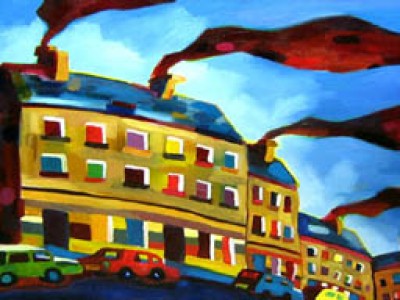What artists or events influenced you early on in your experience?
When I was eight years old I saw a Piet Mondrian painting on the cover of a magazine. It struck a chord, the use of black lines, blocks of colour, and white spaces.
Later that year at my school, a painting competition was held. There had been themed competitions before during the year, but in that particular week, the contest had a “leave it up to you” theme. So I used my imagination and came up with something abstract. My teacher truly appreciated how different my entry was. No one at school knew it, but making abstract art was what I did at home, up in my room. I did all sorts of geometric colouring books. I measured out all these squares on paper and then would sit quietly staring at them.
Winning that contest was like, wow! It was one of those instances in your life that goes deep down.
How was your school experience, considering you had these artistic abilities?
As a kid I had low self-esteem and was shy, even reclusive, seeking approval, but not really. I was lazy, rather lost in school. Though I was okay at maths, English was never my best subject. It was so awkward, that age—but winning that competition felt great. It was something I’d done completely on my own.
I’d say that from age 10 to 20, I wasn’t allowed to do art the way I wanted. I hated high school. It beat out of me what little was left of my confidence. It was all a popularity contest there, and not just among the kids. It was with the teachers, too, and their favourites.
I feel I lost a lot of time in those years—it regressed me, and it did damage.
If you had not become a visual artist, what other path might you have followed?
Two paths come to mind: I’ve always known that I would be wonderful as a nurse/healer, and that I would enjoy connecting with people in that way. And I’m a musician—I play the guitar and sing. I’m more confident now in my work, but I don’t have any ambitions to play with other musicians or to perform in front of people.
In your artist bio you mention that as a young adult, you moved from Cheshire (near Liverpool) to Glasgow. What was it that made you gravitate toward there, then settle?
My older sister, Emma, lived there. For I time I lived in London, and whenever I visited her in Glasgow, I felt a friendliness I’d never before experienced. I also fell in love with the architecture, the buildings. I’d ask my sister, “Can I stay an extra week?” I eventually let an extra week turn into six or seven years.
During your time in Glasgow, what forms or themes did your artwork have?
Glasgow was really where I got my start. Around age 20 or 21, I committed myself to being an artist. I drew buildings at lunchtime while working at a coffee shop. I became good at it, drawing the tenements and working-class buildings, and people began to buy my work. Everyone generally loves visual arts there. Scottish colourists are powerful and well known. I was selling artwork not only to tourists, but to the dockworkers—they all had an appreciation of art and were so proud of their city.
How is it for you to be a working artist in the United States as compared to the United Kingdom? How do the influences differ?
Here in the Northwest there is a lot of glass, woodcarving, and sculpture.
I know that if I’d stayed in the U.K., I might not ever have begun my work using oil and wax for my paintings. It’s a technique of mixing oil with wax paste and actually carving into it; it gives the work a lovely sketched, textured style.
English and Scottish artists typically have a bit more of a traditional style to their work, but here in the U.S., there’s an impetus to create your own thing—and also to know what your audience likes. People in the U.S. are very into the artist—the artist’s process. You need to sell yourself. And for that, you can deviate more from traditions.
How do the business aspects differ?
When I came to Portland I began selling my artwork at the Saturday Market. It was similar to my business in Glasgow in that it was selling art to local people. But the Glaswegians were far more into the artwork itself; if they liked a piece of art, they bought it. I found that people here wanted to know more about the artist, and the artist’s process. They wanted the background, the story of the artwork. It was hard for me to get used to having to present myself and explain the process. I’ve had to learn to maintain my bio, list of shows, information on collections, and so on, and keep it relevant. I’ve had to learn to present myself as well as the artwork.
I’ve also found my more recent work developing a different audience, and so to honor that, my friend and business partner, Brian, and I have created two separate websites: www.bibbyscapes.com to feature the classic works, and www.iambibby.com to feature my newer works.
Do you have any advice for an aspiring artist who’d like a full-time career in the visual arts?
Don’t give up!
I believe there are really talented people working, say, at Starbucks. But you just have to sit down and DO it. Potential talent is only that; hard work is 95% of it.
Only one in 100 million people have that insanely genius ability to succeed without a lot of hard work. I realized this when I started painting. It really blew my mind—I looked at all the people who’d inspired me through the ages. What was the constant among them? I mean, some were married with kids, some were extroverted, or hermits, or confident, or mental. What they all had in common was that they did it—painted, wrote books, made movies. They sat down and DID it.
What are some of your favorite haunts in Portland?
I love that we’re living in what was once a rainforest. I love hiking in the wintertime and also going to the rivers in the summer. It’s nice up on Mt. Tabor.
I enjoy the Bagdad Theater during the day. It’s nice and relaxing to go there and hang out. Also I love the food carts on Hawthorne and 12th. And the Saturday Market is a wonderful thing. It’s changed a lot!
It’s coming up on nine years now that I’ve called Portland home. Portland will always be in my life. I like to stay in a place and get to know it, and make my imprint on it. I’ve found that you can become part of a place, and also change as a person.



